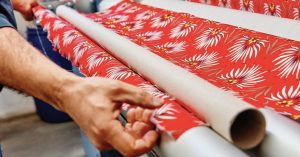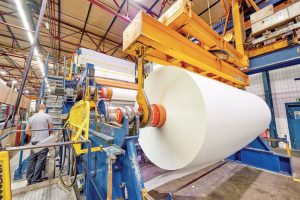
fabrics created using
dye sublimination methods have brilliant, colorful designs.
State-of-the-art, family-owned Neenah Coldenhove serves global customers with its innovative paper solutions.
By Mike Todaro
Everyone in the apparel industry has sent and continues to send nearly infinite volumes of digitized everything to the cloud(s), especially brilliant colorful designs and prints. Now it is time for the rain, for this tsunami of pixels to begin to fall and ironically, as important as the pixels that fall is the paper into which they land and dry. This paper is about … paper.
Shorter cycles are driving faster fashions with design-to-consumer turn times measured not in months but weeks. This fact is seen during Americas Apparel Producers’ Network (AAPN) meetings where the fiber, fabric, trim, factory and brand executives are all sitting in the same conference. Speed comes from ink and paper.
Inkjet Sublimation
The inkjet sublimation process starts with a high color fabric design that is printed onto special paper. Next, the paper is overlaid with a man-made fabric and run through high pressure rollers. During this step, the ink turns into a gas and combines with the fabric at the molecular level. The process creates designs that will never fade or run.
The apparel industry has seen countless trends and changes over the years including digitalization, globalization, computerization, fast fashion, short cycles, verticalization, 2D/3D systems, lean manufacturing, and so much more. Today, digital rules and nothing proves this more than inkjet sublimation.
Anyone in today’s supply chain located in between the designer and the consumer, is seemingly in the way. Advances in inkjet sublimation have even in some cases made the designer and the consumer the same person! This technology allows 10-minute turn times for small shops and one-day turn times for 20,000 yards of fashion fabric for the major players.
It’s The Paper
The Atlanta-based AAPN recently visited member company Neenah Coldenhove, the Netherlands. Since 1661, Coldenhove has produced paper at its facility — a place chosen because of the clean, clear, soft water springs.
Trucks arrive at Coldenhove with virgin cellulose harvested from renewable controlled forests of fast-growing eucalyptus trees. The environment is an emotional issue and Coldenhove goes above and beyond in its sustainability efforts. It has been recycling and innovating its water and energy use for nearly 350 years.
Some 95 percent of this special regional water used in Coldenhove’s production goes right back into production. The other 5 percent is used in production elsewhere on site. This Dutch company ironically will soon install an energy windmill. The company has a written goal to reduce energy by 8 percent by 2020.
The sublimation paper manufacturing process starts with pulp, which is turned into paper in a continuous sequence. Fiber and filler are soaked in water, filtered, then run through an enormous machine out of which emerges massive rolls of coated paper, ready for inkjet sublimation. Coldenhove invented a coating that is key to full color transfer.
The company knows how to make paper of a consistent weight and strength that creates predictable prints at high speeds. Its special coating is added inline as an integrated part of the process, not later. Without this key coating, more than 35-percent of the ink is absorbed into the paper and never reaches the fabric.
It is this coating — the target for the pixels of ink — that delivers instant drying and quick release of nearly 100-percent of the expensive inks to create sharp images. Currently, this paper is delivered within 48 hours to 70 countries worldwide.
It’s The Culture
How does a company that began operations in 1661 find itself still hiring and growing and expanding its customer base today? The answer is by never stopping the creation process. As one senior manager reported: “It is not our machines or fiber or paper or coating, it is our culture that gives us a competitive advantage.”
This is why such a historical company has managed the exponential growth in volume and breadth of global coverage to more and more companies. Over this decade, for example, it has experienced double digit growth every year.
The paper Coldenhove produces is not a new technology, it’s what the company does that is so innovative. It is the company’s focus to keep ahead of the ever-changing standards of the fashion industry that matters. The speeds and flexibility of digital printing is bringing production back closer and closer to the designers, to the Americas.

Ron Sportel, Coldenhove’s manager of innovation and development, saw the digital revolution coming in the industry. He invented digital inkjet sublimation paper, and the design that is used to apply the coating inline. Both inventions are key to Coldenhove’s value and brand name leadership in the industry.
In 2012, the industry saw a dramatic advance in the speeds of inkjet printers with increasing scale. This put enormous pressure on producers of both ink and paper. Coldenhove responded with its first product, JETCOL HTR 1000®. Today, the company offers 14 branded products with more in development.
Coldenhove prints sublimation inks on different polyester substrates with the knowledge that there is an optimum paper for every application, and countless applications. Some 43 percent of its market is in fashion, 30 percent in sporting applications, 15 percent in signage, and the balance is in home furnishing applications.
It’s The Speed And Accuracy
AAPN member El Salvador-based Textiles Opico SA de CV (TexOps) was founded in 2009. The company started slowly with inkjet sublimation printing and has reached a large scale of investment there today. TexOps has used Coldenhove paper from the very beginning.
“My partner David Ha went [to Coldenhove], very impressive place,” said TexOps President Juan Zighelboim. “They are a key vendor to us, very good reputation, make a high-quality product. We are very loyal due to quality, service and value. We don’t switch out for cheaper knock-offs available in the market.”
One mill in Europe that prints fabric for Zara’s dresses uses a single pass high-speed inkjet printer with six bridges of 100,000 nozzles each firing pixels of 3 picoliters of ink onto paper passing underneath at 2 meters per second. Think about that. If the mill receives a digital file in the morning, it can ship 20,000 yards of fashion fabric that evening. This is not only amazing speed, but can also be accomplished with monumental accuracy. This is design at its best, at speeds that are the world’s fastest for garment cycle times with margins no other brand can touch.
In her presentations, Coldenhove marketing executive Reshma Bhansing quotes Thomas Fuller who said: “All things are difficult before they are easy.” Pair that with Margaret Mead’s quote: “Never doubt that a small group of thoughtful, committed citizens can change the world. Indeed, it’s the only thing that ever has,” and this sums up Coldenhove’s team.
The power of this process is in its simplicity — printer, ink, paper, press and polyester fabric. The surprise, the secret ingredient, the piece of the puzzle that delivers exponentially more color and value than you ever imagine comes wrapped to you as what it is — the paper, the target of the designs you want to matter.
Editor’s Note: Mike Todaro is managing director of the Atlanta-based Americas Apparel Producers’ Network (AAPN).
May/June 2019




